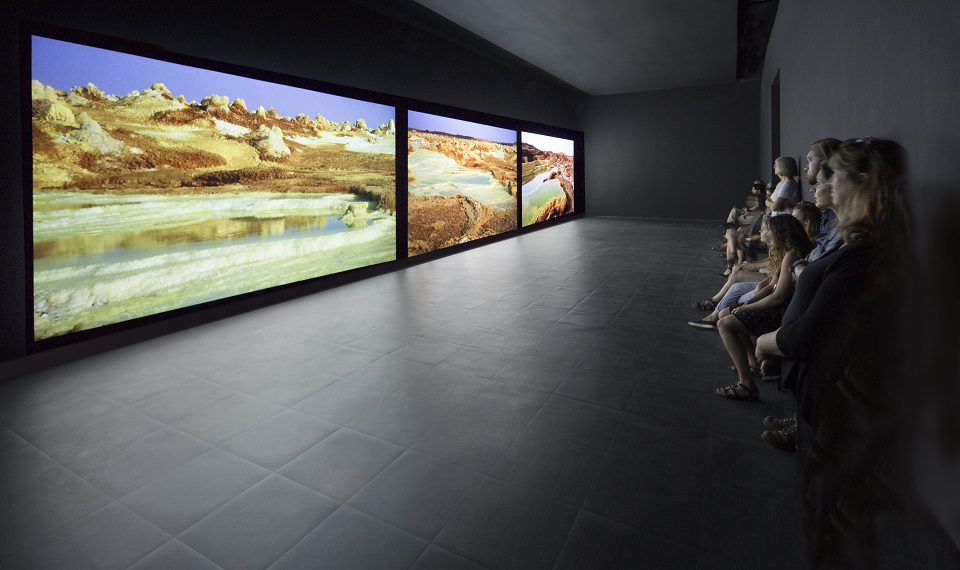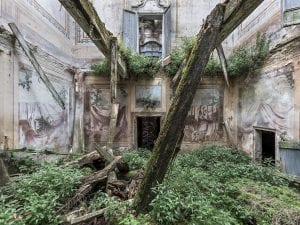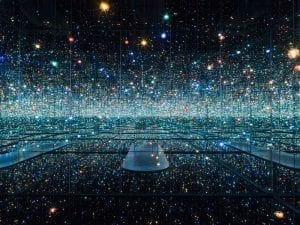The New York-based video artist Janet Biggs is drawn to explore hazardous territories and forbidding landscapes of natural reserves. From expeditions to coal mines in the depths of the North Pole, to gaseous sulfur quarries in Indonesia, and her most recent trip to the Afar region located in the eastern horn of Africa between Ethiopia, Eritrea, and Djibouti, Biggs juxtaposes the formidable beauty of nature with the hardship of enduring the landscape.
In Afar, her new mesmerising three-channel 9-minute video installation that opened at the SCAD Museum on 23 June , Biggs captures the landscape and its people. Projected on three flat rectangular floor to ceiling screens that line one wall of the gallery, wide angled shots of vast crystalline salt lakes that are formed from deposits of the Awash river that flows through the Danakil Depression (the northern part of the Afar region) for less than six months of the year before it dries up, fill the screen.
Nomadic by nature, the Afar people who follow the clouds in search of scant rainfall survive by selling salt in the local markets. Shown scraping salt with rudimentary tools and loading hardened slabs of sodium onto their camels, Biggs cuts between scenes of the Afar community on the salt flats, segments of vast swaths of the landscape, and intimate close up portraits of the men who are exposed to harsh temperatures that average between 110-120 degrees.
In a panel discussion prior to the opening of her show at the SCAD Museum, Biggs spoke of being self-conscious as a white woman working with the Afar people in Africa. Later, during a dinner conversation, when asked how she felt about capturing a community she hardly knew, Biggs acknowledged her challenge. Although she made two short trips to the Afar, it was not a place that was easily negotiable.
In her video, she avoids the pitfall of culling exotic narratives about unknown nomadic people by attempting to showcase her subjects exactly as she saw them: mostly as salt miners surviving on a barren landscape and expansive volcanic terrains of red hot gurgling lava that spools and flows. Unlike her five-channel video A Step On the Sun (2009), made in the treacherous sulfuric mines of Indonesia that featured workers toiling in an exploitative environment, here her subjects seem like a community unto themselves.
In several close up shots in the video, a man from the Afar territory looks into the camera. As Biggs zooms in his impenetrable gaze summarizes the complexity of her task. Known for their pride, the man’s expression is neither formidable nor approachable. In another scene Biggs films a jovial group of youngsters relaxing together. Here we see a young girl taking the lead and pulling at a hookah with her male compatriots. But in less discernible segments, the artist juxtaposes dancers from the Elizabeth Streb troupe in New York hurling themselves against a metal barricade. The dancers’ movements are meant to imitate the agitation of young Afar children that she saw during a political event who had been brutally corralled by the police in a van with wire mesh windows.
Although there are many unanswered questions in the work, Biggs never fails to dignify her subjects. Her decision to excise numerous shots of young men armed with guns that dotted the landscape is her effort to delink the work from a Western perspective of portraying unknown communities in Africa as threatening thugs. Regardless of whether or not Afar can be deemed as a successful portrayal of a community, Biggs’ effort to acknowledge the difficulty of being a foreign observer results in a methodology that stays clear of imposing any judgment or authoritative point-of-view.
Instead she celebrates the magnificence of the natural world and its relatively unknown nomadic inhabitants. If the artist’s lack of engagement with her subjects seems a bit guarded, her distance and studied unobtrusiveness enables a poetic vision of the land that is as achingly beautiful as it is prohibitive to live on.
Bansie Vasvani
Janet Biggs, Afar is at The SCAD Museum of Art until 25 September. For more information: www.scad.edu
Credits:
1.Installation view of Afar at SCAD Museum of Art. Photo courtesy of SCAD.





